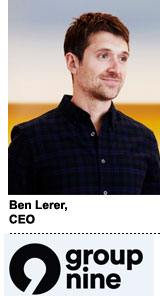Change seems constant in the media business.
A chain of digital media consolidations in 2019 has created new scaled players: Group Nine Media and PopSugar; Refinery29 and Vice Media; and Vox Media and New York Media.
Besides a greatly transformed competitive landscape, 2020 will see publishers wrestling with new challenges. Privacy and regulation, for instance, are making publishers rethink their relationships with readers and how to use that relationship with advertiser clients.
But despite all of these new factors, publishers will still focus on the basics: quality content that generates engagement.
AdExchanger asked Group Nine Media, BuzzFeed, Insider Inc., Dotdash and Meredith the following question: What’s the biggest change publishers should expect in 2020?
Group Nine Media: Scale Is The Solution 
“2019 was a major shake out for digital media,” said Group Nine Media CEO Ben Lerer. “It happens in every growth industry and it’s a necessary and healthy, albeit oftentimes painful thing to go through.”“The tough times for smaller players aren’t over, but in 2020, I believe you’ll see the companies that have amassed some real scale emerge as the true, next generation leaders. Audiences are going to continue to flock to digital and mobile and there is room for a small group of legitimate winners to thrive here.”
BuzzFeed: Build Engagement, Bring In Contextual Ads
 “Publishers are creating more content than ever before, but in 2020 the question will remain, how to break through and actually engage audiences?” said Ken Blom, SVP of ad strategy and partnerships at BuzzFeed.
“Publishers are creating more content than ever before, but in 2020 the question will remain, how to break through and actually engage audiences?” said Ken Blom, SVP of ad strategy and partnerships at BuzzFeed.
“BuzzFeed will continue to create content that serves a purpose in our audiences’ lives – content that provides a utility – from learning how to cook to discovering your new go-to item to buy. These audiences aren’t just consuming content, they are taking real-life action.
“In 2020, contextual alignment to audiences will be key for all advertising, especially programmatic. Contextual alignment will be more important than ever with increasing privacy regulations resulting in limited data and targeting.”
Insider Inc.: Data Divide Is Coming
“A data divide emerges,” said Insider Inc. Publisher and CRO Pete Spande. “Historically, publishers  have not built strong data products and ceded much of that ground to ad tech and platforms. The changing landscape (both technical and regulatory) provides an opportunity for publishers to regain ground ceded in the past 15 years.”
have not built strong data products and ceded much of that ground to ad tech and platforms. The changing landscape (both technical and regulatory) provides an opportunity for publishers to regain ground ceded in the past 15 years.”
“As third-party cookies diminish in usefulness and reach, publishers with quality, privacy-compliant data find a new line of business producing a significant impact on direct and indirect ad sales channels. Publishers with minimal to no data strategies find themselves in a race to develop and resource to compensate for this deficiency or see ad yields decrease precipitously.”
Meredith: First-Party Will Rule The Day
 “In this new era of privacy, media companies that serve the consumer with an increased focus on utility, transparency, quality experience and optionality will develop a stronger permission-based consumer relationship. This consumer relationship will provide a significant advantage in the advertising market,” said Alysia Borsa, EVP/Chief Business and Data Officer at Meredith.
“In this new era of privacy, media companies that serve the consumer with an increased focus on utility, transparency, quality experience and optionality will develop a stronger permission-based consumer relationship. This consumer relationship will provide a significant advantage in the advertising market,” said Alysia Borsa, EVP/Chief Business and Data Officer at Meredith.
“Privacy and browser changes are going to force a shift in the mix of media buying, both across channels as well as in digital itself. Media companies with quality first-party data (based on a direct, permission-based relationship with the consumer) will capitalize on the opportunity to provide meaningful first-party consumer insights, rich contextual and real-time, intent-signal solutions.”
Dotdash: Media Isn’t Broken
“The 2019 narrative around publishing was that publishing is somehow broken. There were a number of  high-profile businesses that raised capital irresponsibly and deployed it irresponsibly and then when the businesses did not work, the narrative became something was wrong with the industry,” said Dotdash CEO Neil Vogel.
high-profile businesses that raised capital irresponsibly and deployed it irresponsibly and then when the businesses did not work, the narrative became something was wrong with the industry,” said Dotdash CEO Neil Vogel.
“We actually don’t think that’s the case, and our performance as well as the performance of a number of other publishers proves this – and we think this will become even clearer in 2020. The upcoming year is going to be great for those media outlets with high-quality content and a clear market fit, that deliver targeted audiences effectively – quality publishers will always win.”













